Task Link Upgrades for OnePager 6.1
Contents
- 1 Introduction to the OnePager 6.1 Task Links Upgrade
- 1.1 OnePager 6.1 Task Link Upgrade - Overview
- 1.2 The New Template Task Links Tab
- 1.3 The New Project-View Properties Task Links Tab
- 1.4 Importing Data-driven Task Links after a Project View is Created
- 1.5 Using the Right-Click on Task Link Context Menu
- 1.6 Selecting Multiple Task Links
- 1.7 The Selecting all Task Links Feature
- 1.8 Showing and Hiding Data-Driven Task Links
- 1.9 The New Where Are My Links? Form
- 1.10 Using Task Link Filter Rules
- 1.11 Globally Editing Task Links
- 1.12 Editing Task Links
- 1.13 Creating and Editing Daisy Chained Manual Task Links
- 1.14 Task Links and Virtual Summary Tasks
- 1.15 Task Links and Absorbing Tasks
- 1.16 Changes to Task Links when Moving Task/Milestones, Rows, or Swimlanes
- 1.17 Behavior of Data-Driven Task Links When Adding or Replacing Snapshots
- 1.18 OnePager 6.1’s Data-Driven Task Link Import Process
- 1.19 Import Process Summary
- 1.20 Saving OnePager 6.1 Project Views to Previous Versions
- 1.21 Opening Previous Versions of OnePager using OnePager 6.1
- 2 Links to Detailed Articles
- 3 Related Links
Introduction to the OnePager 6.1 Task Links Upgrade
1) OnePager Pro and Express always supported the creation and showing of Task Links (previously called Event Links). The process for creating and editing Event Links was limited and totally manual.
2) What was not previously possible was to import Predecessors data from your Microsoft Project or Excel source plan and have OnePager produce a project view with these dependencies graphically displayed.
3) The two illustrations below show a simple Microsoft Project source plan with Predecessors data and the OnePager Pro 6.1 project view created with the Task Links Upgrade:

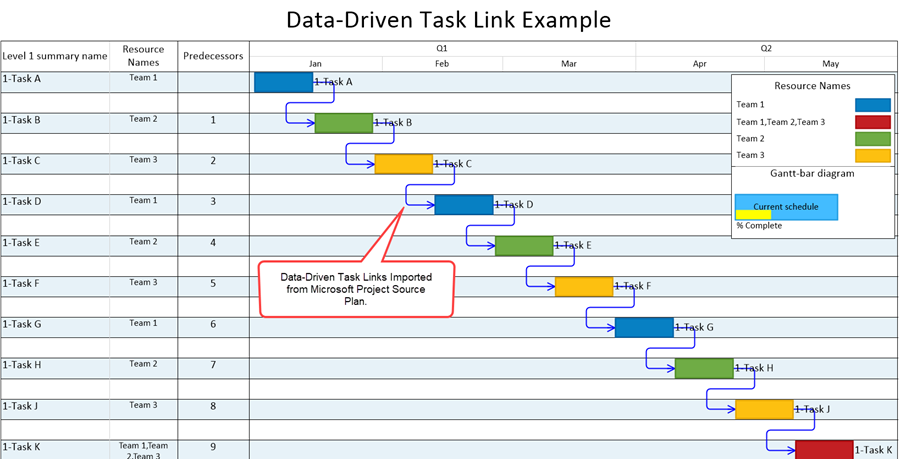
OnePager 6.1 Task Link Upgrade - Overview
4) With OnePager Pro and Express 6.1 you have the following enhanced capabilities:
- a) Task Link information can be imported from both Microsoft Project and Microsoft Excel source plans and made available for display and editing with controls for showing them in the project view.
- i) Task Links imported from source plans are called data-driven Task Links.
- ii) When discussing data-driven Task Link imported from Microsoft Project, the capability to import data-driven Task Links from Microsoft Project Server and Microsoft Project Online is also supported.
- b) Task Link editing capabilities are expanded so that you have a greater variety of options for formatting Task Link arrow shapes, arrow sizes, connection line options, connection line corner radii, Task Link Dependency Types, and Vertical and Horizontal Anchor points on task/milestones.
- c) Manual editing capabilities are also enhanced so you can perform drag and drop operations and edit the properties of any and all Task Links using enhanced Task Link formatting options.
- i) Manual Task Links can be Daisy Chained. That is, you can select more than two tasks/milestones and create a series (i.e., daisy chain) of manual Task Links connecting these tasks/milestones.
- ii) You have full control over Task Link formatting and which Task Links are shown or hidden in project views through the use of the new Task Links tabs on the Template and Project-View Properties forms.
- iii) Filtering control over showing (or hiding) Task Links is provided in a new Task Links Filter Rules form.
- d) In a similar fashion to how OnePager 6.1 assists you to manage hidden tasks, OnePager 6.1 provides a Where Are My Links? form that lists Task Links specific to each snapshot and allows you to edit the show/hide status of any Task Link in a snapshot.
- e) You also have the capability to manually select a Task Link with a right-click and use a context menu to perform manual editing on the manual or data-driven Task Link.
- f) You can perform enhanced editing of manual Task Link properties with the enhanced Task Link Properties form.
5) OnePager Express 6.1 is enhanced such that you can import Dependency values on tasks from Microsoft Excel source plans where the syntax format selection for specifying predecessor relationships corresponds to the Microsoft Project standards or the syntax format selection used by Oracle’s Primavera P6.
6) OnePager Pro and Express 6.1 are designed to process Task Links that are specified as Predecessors ONLY.
- a) Although OnePager 6.1 does not import Successor data from your source plan, successor information is the inverse on predecessor information found in your source plan.
- b) This approach guaranties that all your data-driven Task Links are based on valid information from your Microsoft Project source plan.
The New Template Task Links Tab
7) OnePager Pro 6.1: You have the ability to globally control the properties for all Task Links in OnePager 6.1’s Template form before a project view is created. The Template form’s new Task Links tab for OnePager Pro 6.1 is shown below:
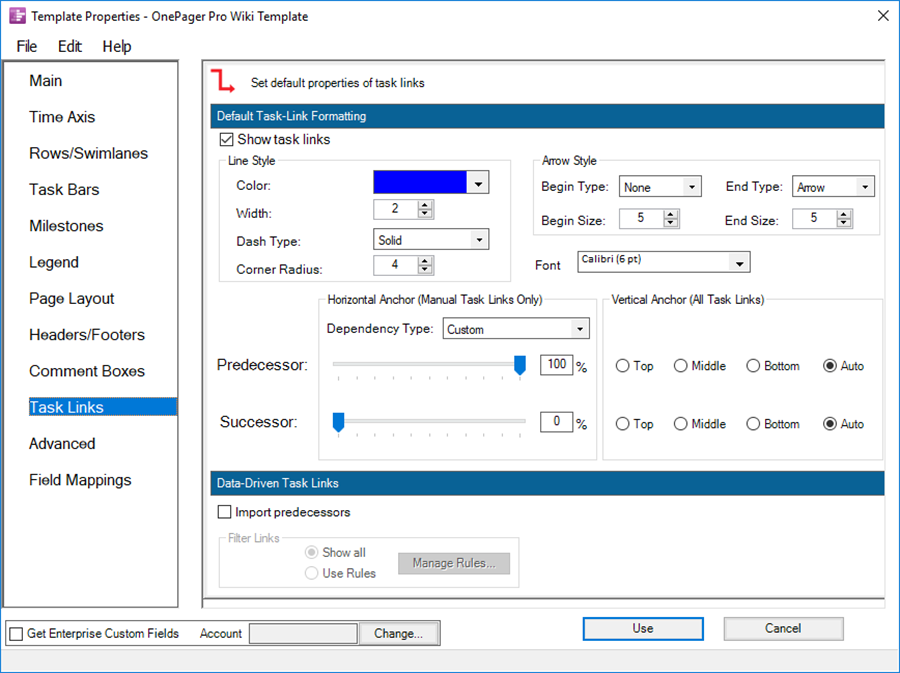
- a) In the Template form’s Task Links tab, the Import predecessors checkbox is normally unchecked meaning that the data-driven Task Link import feature is turned OFF.
- b) OnePager Pro 6.1 assumes that the Predecessors field from the Microsoft Project source plan is used for the data-driven Task Link information source. OnePager Pro 6.1 only imports predecessor data from the Microsoft Project Predecessors field.
- i) Although OnePager 6.1 does not import Successor data from your source plan, successor information is the inverse on predecessor information found in your source plan.
- ii)This approach guaranties that all your data-driven Task Links are based on valid information from your Microsoft Project source plan.
8) OnePager Express 6.1: The Template form Task Links tab for OnePager Express 6.1 is a little different from that of OnePager Pro 6.1 since Microsoft Excel source plans do not have a unique field defined for Predecessors or Successors.
- a) In the Template form’s Task Links tab, the Import predecessors checkbox is normally unchecked meaning that the data-driven Task Link import feature is turned OFF.
- b) For Microsoft Excel source plans, you must tell OnePager Express 6.1 which field in your source plan to use and what syntax format selection to use for the Predecessors field’s format.
- c) The Template form’s Task Link tab for OnePager Express 6.1 is shown below with the dropdown menu of possible Predecessor source plan fields:
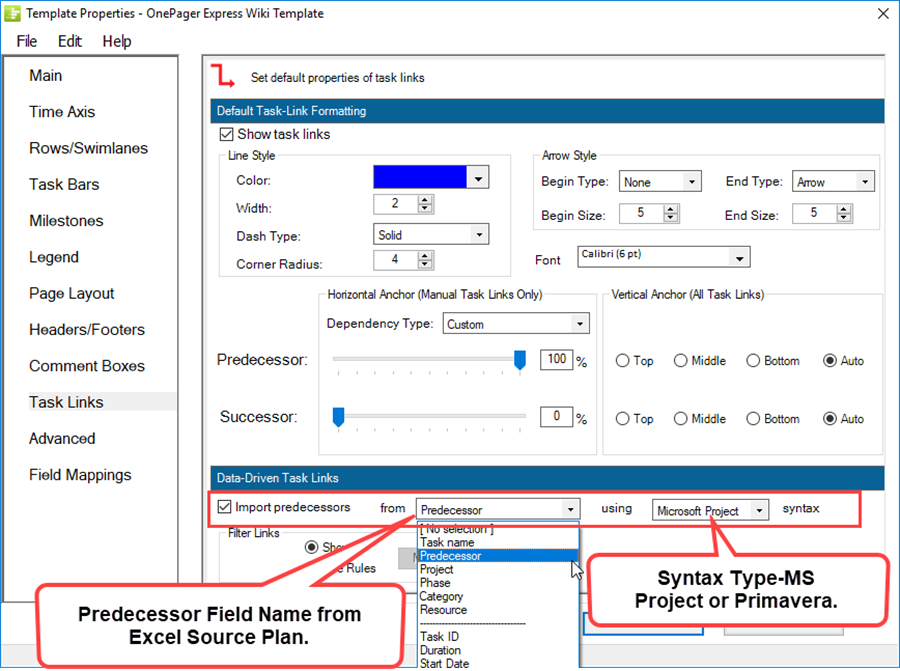
- d) The OnePager Express 6.1 Template form Task Link tab picks up the list of possible Predecessor fields if a Microsoft Excel source plan is loaded. Otherwise the dropdown list is minimized if no source plan is loaded.
- e) There are two syntax format selections for Microsoft Excel source plans. These are:
- (1) The standard Microsoft Project Predecessor/Successor field syntax, or
- (2) The Oracle Primavera P6 Predecessor syntax.
9) Template Form’s Task Link Tab’s Controls: OnePager Pro and Express 6.1 supports the visual representation of all four Task Link Dependency Types including Finish-to-Start (FS), Finish-to-Finish (FF), Start-to-Finish (SF), and Start-to-Start (SS) with proper Begin and End point shape placement on the Predecessor and Successor task/milestones.
- a) It is assumed that if data-driven Task Links are imported they are to be shown so the Show task links checkbox is checked.
- b) Additionally in the Default Task-Link Formatting control group there are established settings for:
- i) Line Styles
- ii) Arrow Styles
- iii) Font properties
10) There are controls available to globally set the Horizontal Anchor positions for manual Task Link’s Begin and End point shapes for all Dependency Types along the Predecessor or Successor task/milestone’s timespan as shown by the slider bars in the illustration above.
11) For all Task Links (manual and data-driven) you are able to globally set the Vertical Anchor positions of a Task Link’s Begin and End point shapes on the Top, Middle, or Bottom of the Predecessor and Successor task/milestone. You can choose to let OnePager 6.1 determine the Vertical Anchor positions by selecting the Auto options.
12) In the Data-Driven Task Links control group shown above the default setting for the Import predecessors checkbox is unchecked.
- a) This is done so that new project views are not created with all available data-driven Task Links information imported and shown unless you specifically direct such an action through the Template form.
- b) You are given the opportunity to import data-driven Task Links information using the same controls in the Project-View Properties (PVP) form’s Task Links tab in the Data-Driven Task Links control group after the project view is created.
13) When the Import predecessors checkbox is checked in the Template form’s Task Link tab, you have the option to Show all data-driven Task Links or use the Task Link Filer Rules capability by clicking the Use Rules radio button.
- a) Selecting the Use Rules radio button enables the Manage Rules button which is used to access the Task Link Filter Rules form.
- b) This form allows you to establish a set of rules to govern how data-driven Task Links are shown.
The New Project-View Properties Task Links Tab
14) OnePager Pro 6.1: The PVP form’s Task Links tab is almost identical to that in the Template form and is shown below:
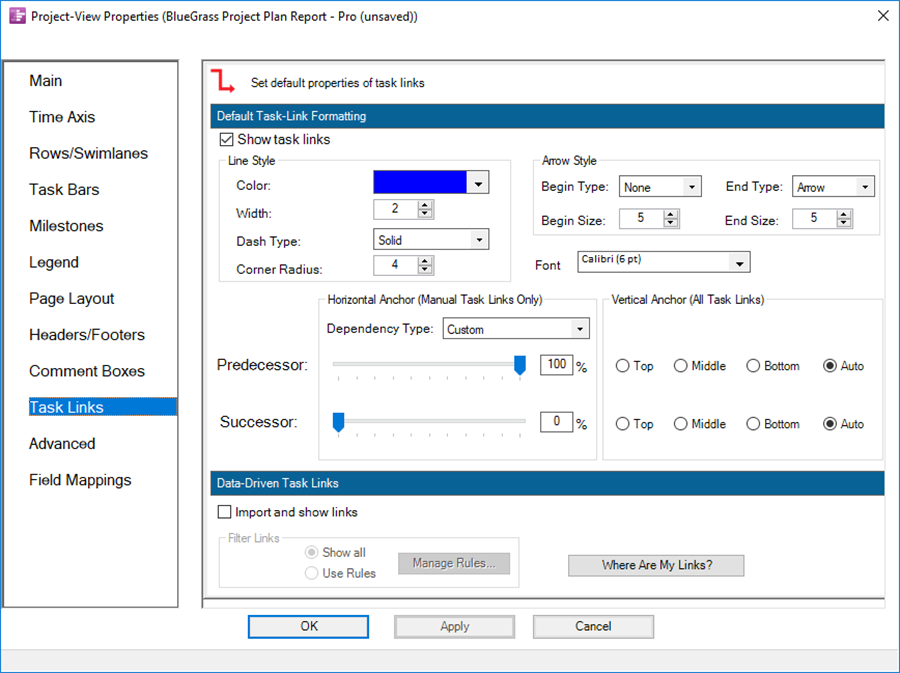
- a) In the PVP form’s Task Links tab the Import and show links checkbox is normally unchecked.
- b) OnePager Pro 6.1 assumes that the Predecessors field from the Microsoft Project source plan is used for data-driven Task Link information.
15) OnePager Express 6.1: The PVP form Task Links tab for OnePager Express 6.1 is also slightly different from that of OnePager Pro 6.1 since Microsoft Excel source plans do not have a standard field to define Predecessors or Successors.
- a) As a result, you must tell OnePager Express 6.1 which field in your Microsoft Excel source plan to use and what syntax format selection to use for specifying the Predecessors fields.
- b) The PVP form’s Task Link tab for OnePager Express 6.1 is shown below with the dropdown menu of possible Predecessor source plan fields:
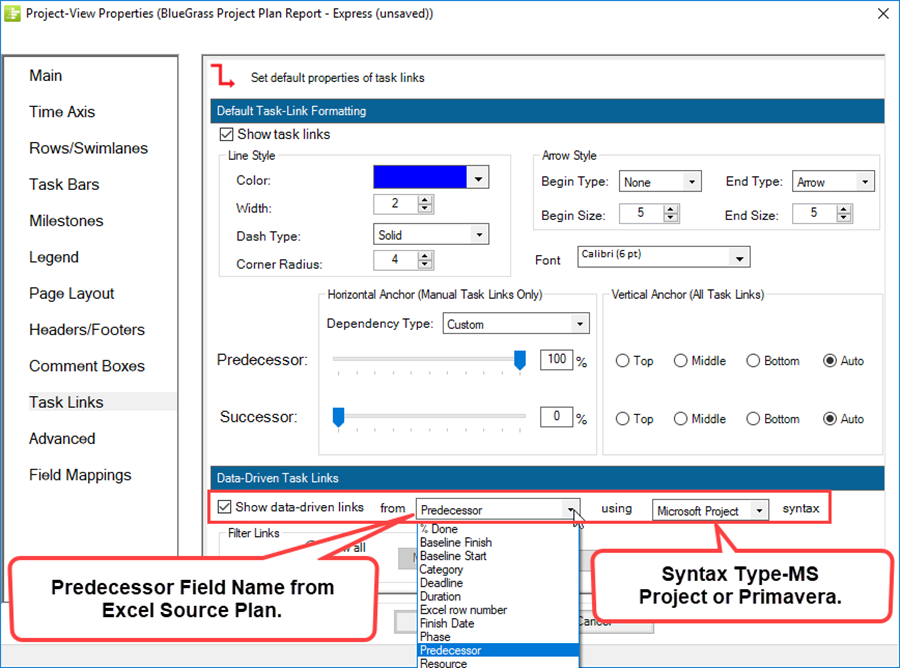
- c) The OnePager Express 6.1 PVP form Task Links tab picks up the list of possible Predecessor fields if a Microsoft Excel source plan is loaded. It makes an attempt to pick an available Microsoft Excel field that most closely resembles a predecessor field for the project view.
- d) The same two syntax format selection choices for Microsoft Excel source plans are available in the PVP form Task Links tab. These are:
- i) The standard Microsoft Project Predecessor/Successor field syntax, or
- ii) The Oracle Primavera P6 Predecessor syntax.
16) Project-View Properties Form’s Task Link Tab’s Controls: The controls in the PVP form Task Link tab’s Default Task-Link Formatting control group are the same as the controls in the Template form Task Link tab’s Default Task Link Formatting control group for both One Pager Pro and Express 6.1. The differences in Task Link tab are only in the Data-Driven Task Links control groups for both OnePager Pro and Express 6.1.
Importing Data-driven Task Links after a Project View is Created
17) The PVP form Task Links tab’s Import and show links checkbox, like the corresponding Import predecessors checkbox in the Template form, is unchecked.
- a) If you decide to check the Import and show links checkbox after the project view is created and click the OK button on the PVP form, OnePager Pro or Express 6.1 goes to the source plan and imports the data-driven Task Link information and shows them.
- b) Subsequent accesses to the PVP form’s Task Links tab show the form changed as highlighted below:
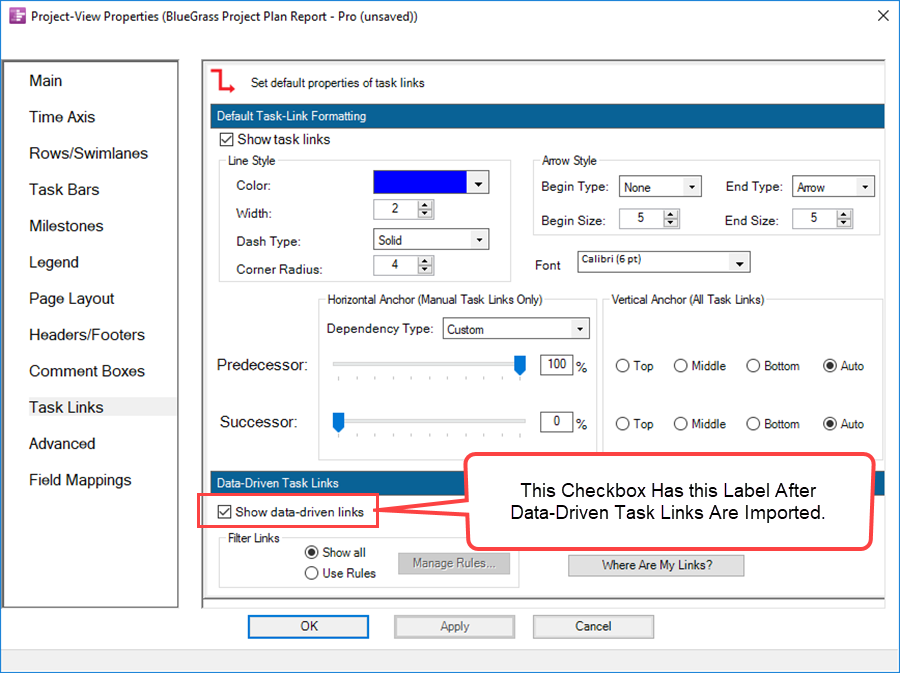
- a) As shown above, the checkbox is now focused on showing or hiding data-driven Task Links as the predecessor data are already imported.
- b) Unchecking the Show data-driven links checkbox as it is now labeled hides all data-driven Task Links once you click the Apply or OK button on the PVP form.
- c) Although hidden, the data-driven Task Links can be reshown by rechecking the Show data-driven links checkbox and again clicking the OK button on the PVP form.
18) There is an additional control in the Data-Driven Task Links control group in the PVP form Task Link tab – the Where Are My Links? button as shown in the PVP form’s Task Links tab above.
- a) Clicking this button accesses the Where Are My Links? form as shown below:
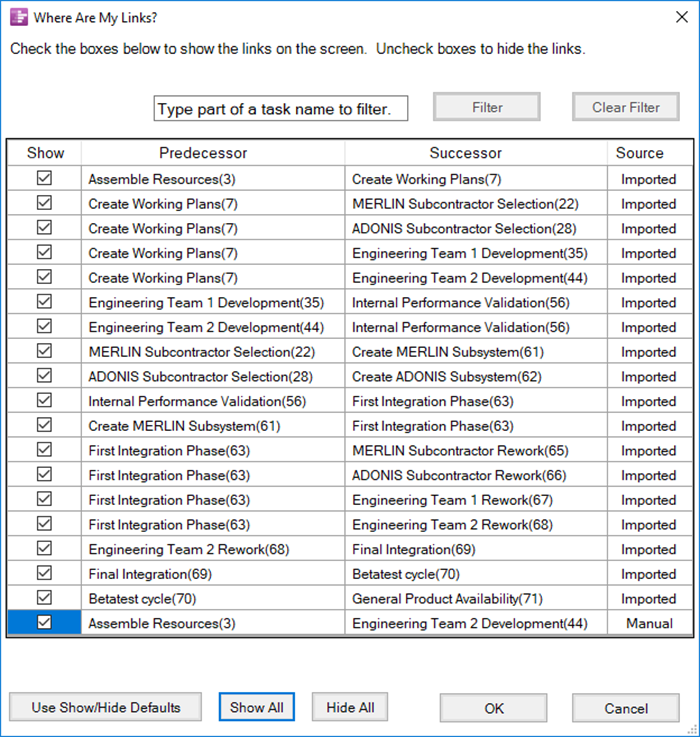
- b) The form above has an entry for each data-driven Task Link and manual Task Link in the snapshot.
- c) There is more information on using the Where Are My Links? form at this section below: The New Where Are My Links? Form.
19) Given the Microsoft Project based BlueGrass Project Plan Report being used in this document and the set of Task Links contained and shown in the Where Are My Links? form above, the project view looks like this:
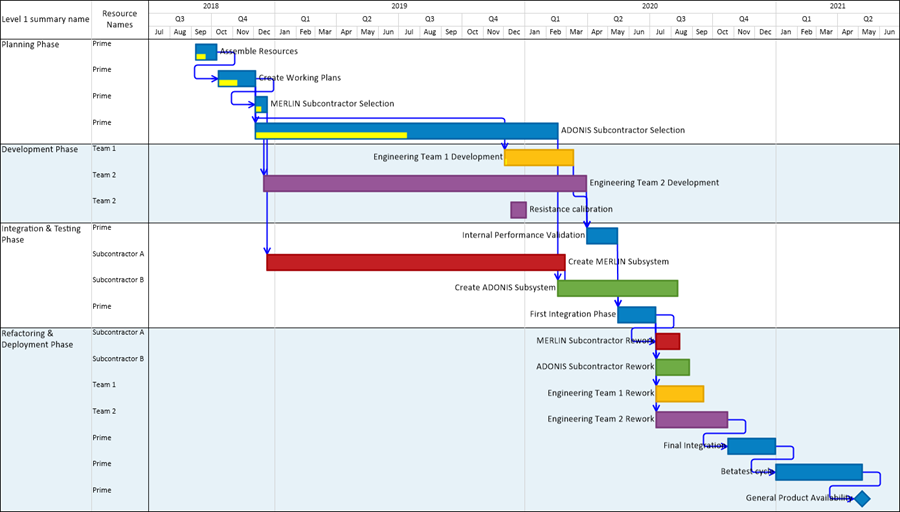
20) Data-driven Task Links are shown in a color based upon the default settings established in the distributed Template forms and carried forward to the PVP form when this project view is created. Above the Task Links are shown in blue.
21) OnePager 6.1 does its best to position the Predecessor to Successor connection lines to avoid overlapping other graphics.
- a) Task Links are shown behind task/milestones but in front of task/milestone labels.
- b) This positioning can be edited.
22) You also have the manual capability to select individual data-driven Task Links and to use drag and drop techniques to route the connection lines between pairs of task/milestones.
Using the Right-Click on Task Link Context Menu
23) Data-Driven Task Links: You can use a mouse right-click on a data-driven Task Link to access its context menu as shown here:
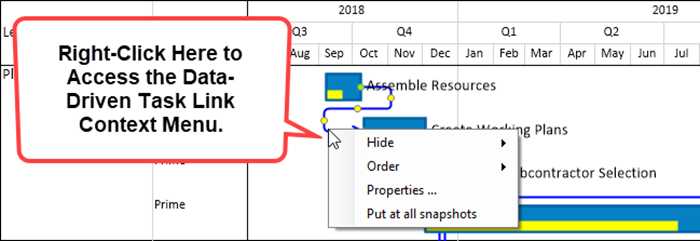
- a) Data-driven Task Links can be hidden in the current snapshot or all snapshots.
- b) Data-driven Task Links cannot be deleted as they are created from Microsoft Project or Excel source plan data.
- c) The Order command functions the same for Task Links as for other objects in the project view.
- d) Clicking the Properties … command accesses the Task Links Properties form as shown below so that you can edit the properties of individual or multiple selected Task Links:
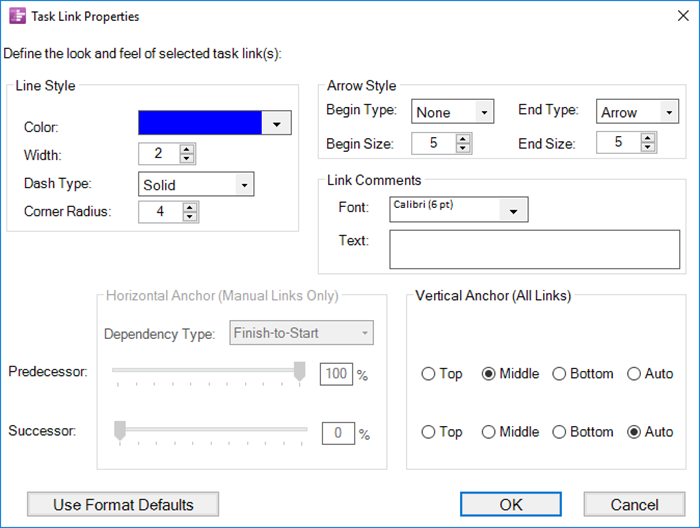
- e) When a data-driven Task Link’s formatting is edited it becomes a mavericked data-driven Task Link.
24) Manual Task Links: As with previous versions of OnePager, manual Task Links can also be selected with a right-click to access their context menu as shown below:
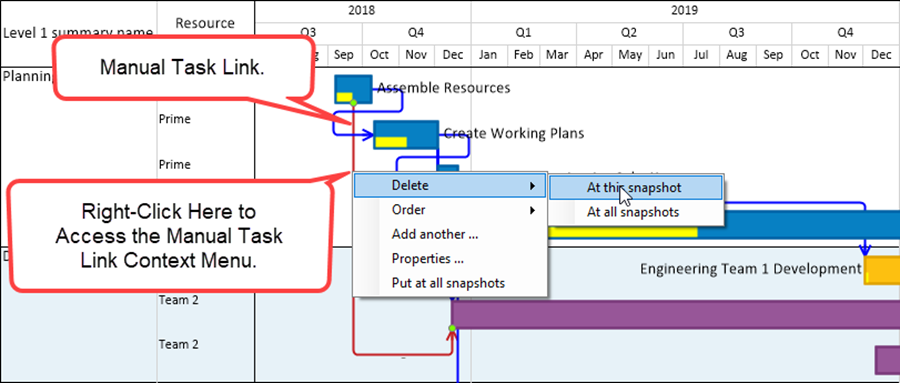
- a) As noted above, manual Task Links can be deleted as there is no correspondence between manual Task Links and Predecessor data from the source plan.
- b) Manual Task Links can be hidden by accessing its Where Are My Links? form entry and unchecking their Show checkbox.
- c) When a manual Task Link’s formatting is edited it becomes a mavericked manual Task Link.
Selecting Multiple Task Links
25) You can use your mouse to select multiple Task Links for editing using the same procedures as used to select multiple task/milestones, Rows, Swimlanes, and Time Axis Level Cells by combining the pointing of your mouse to the Task Link in combination with the CTL+Left-Click.
26) This technique is recommended if you want to edit the Task Link properties of multiple (but not all) Task Links such as their connection line color, arrow head shape, or connection line dash type, for example.
27) Since Task Link connection lines are generally not configured or routed the same, it is not possible to select multiple Task Links and use the drag and drop method on the connection lines to reroute them manually.
28) As an example, suppose you have the BlueGrass Project Plan Report – Pro project view with all data-driven Task Links showing as illustrated above.
- a) Using your mouse with the CTL+Left-Click selects several data-driven Task Links.
- b) When the first Task Link is selected, it is highlighted with green grab points at the Begin and End point shapes and yellow grab points along the connection line if the routing has multiple corners.
- c) When you select the second, third, and so on Task Link using this method, the selected Task Links are highlighted with only green grab points as shown below:
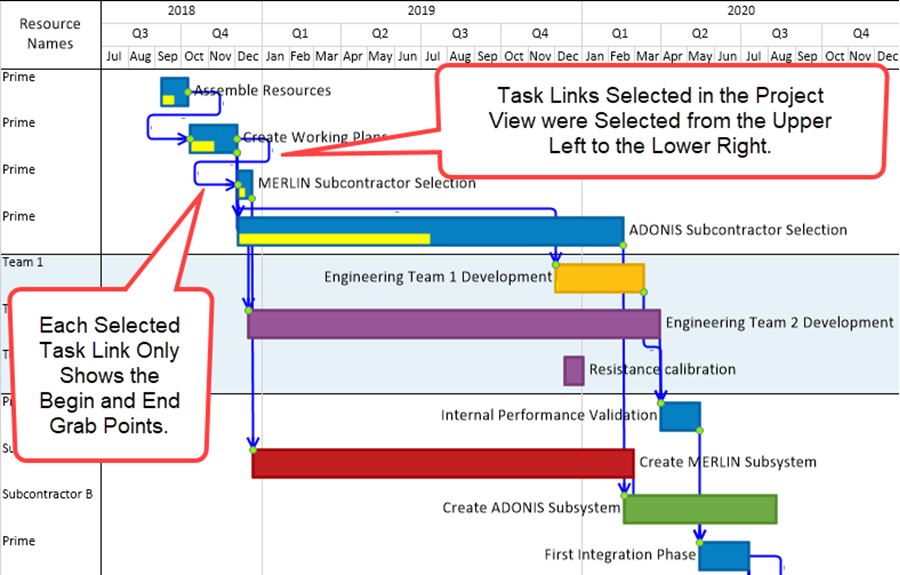
- d) To begin the edit process on the selected Task Links, right-click on any of the selected Task Links to access the context menu and click on the desired command as shown here:
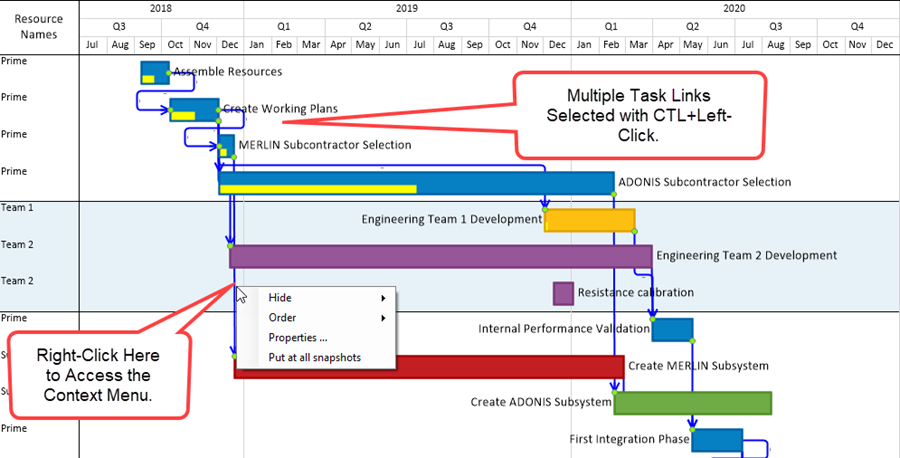
- e) If you select the Properties … command, the Task Link Properties form appears as shown here:
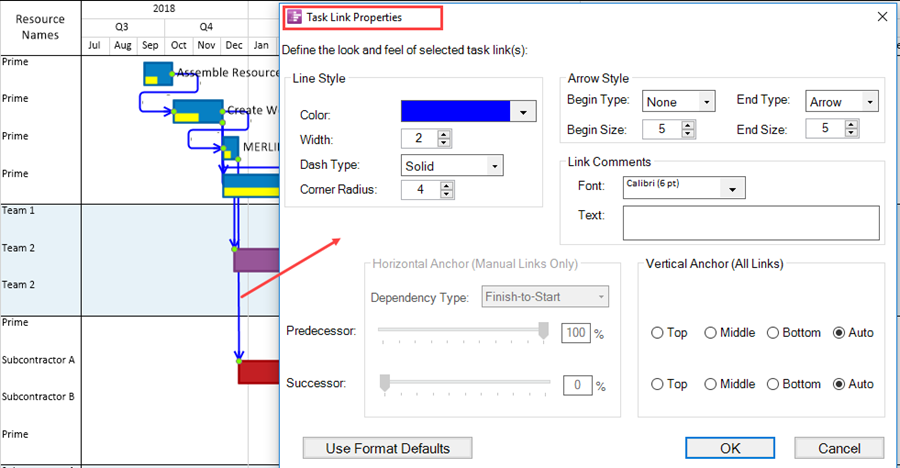
- f) To complete the example, you can edit the Color: dropdown in the Line Style sub-group to red and click OK on the form and get the result shown below:
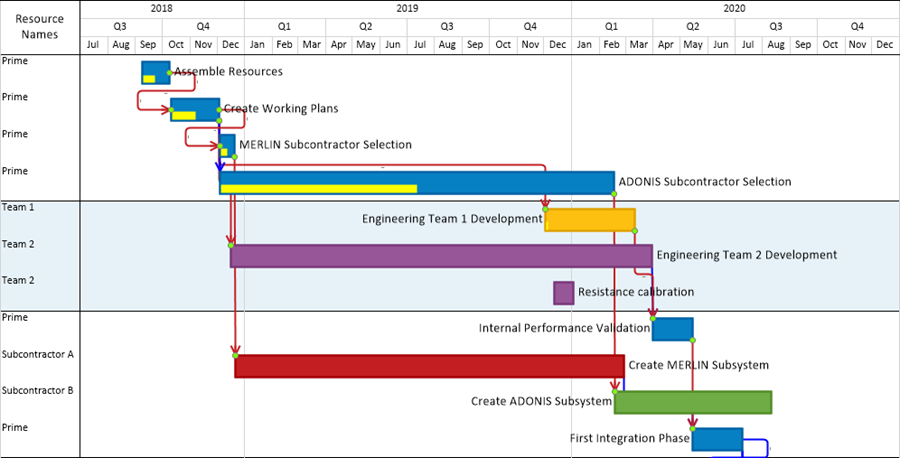
- g) After completing the edit operation above, the selected Task Links remain selected in case you want to make more edits. Clicking anywhere in open space deactivates the selections.
29) Using this technique, you can select multiple data-driven Task Links as well as manual Task Links in one multiple selection operation and perform edits on all selected Task Links.
30) Making any formatting edits to Task Links either singly or in a multiple selection operation makes the edited Task Links mavericks.
31) You can restore multiply selected Task Links back to their default formatting by accessing the Task Links Properties form shown above and clicking the Use Format Defaults button followed by clicking the OK button.
The Selecting all Task Links Feature
32) There is a feature available for you to select all Task Links shown in the project view. It involves using the OnePager Pro or Express 6.1 ribbon’s Home tab as follows:
- a) To select all Task Links (data-driven and manual) in one operation go to the OnePager Pro or Express 6.1 ribbon’s Home tab in the Editing group and click the Select all dropdown and then click the Task Links option as shown below:

- b) This action highlights (selects) all visible Task Links. If you right-click on any selected Task Link to access the context menu (depending on the Task Link type you right-clicked), you can access the Task Link Properties form and edit all the selected Task Link formats in one operation or used the commands in the context menu.
Showing and Hiding Data-Driven Task Links
33) There are four (4) operational considerations to keep in mind when showing Task Links using the data-driven Task Link feature:
- (1) The capability is by default turned OFF in all OnePager 6.1 distributed Templates and must be specifically turned ON for the feature to operate. The Import predecessors checkbox in the Data-Driven Task Links control group shown in the Template form’s Task Link tab is for this purpose.
- (2) Your decision to turn the feature ON or OFF can be made before or after project views are created and even after several snapshots are added.
- (3) Data-driven Task Links and manual Task Links are snapshot-dependent. Formatting of Task Links is consistent across all snapshots, but you do have the ability to show or hide Task Links differently between snapshots.
- (4) For data-driven Task Links to show both the predecessor and successor task/milestones must be imported and at least partially within the project view’s Start/Finish Dates boundaries.
- i) OnePager 6.1 shows data-driven Task Links between tasks that are partially visible in the project view.
- ii) OnePager 6.1 also shows data-driven Task Links to off-page task/milestones as long as one of the pair of predecessor/successor task/milestones imported is within the project view’s Start/Finish Dates boundaries.
34) Please note that lag times which can be included in Microsoft Project Predecessor field data do not change the appearance of data-driven Task Link visualizations.
The New Where Are My Links? Form
35) OnePager 6.1 supports the previous version’s capability to create, edit, and delete manual Task Links.
- a) Manual Task Links are accounted for as are data-driven Task Links using the Where Are My Links? form.
- b) The Where Are My Links? is shown here:
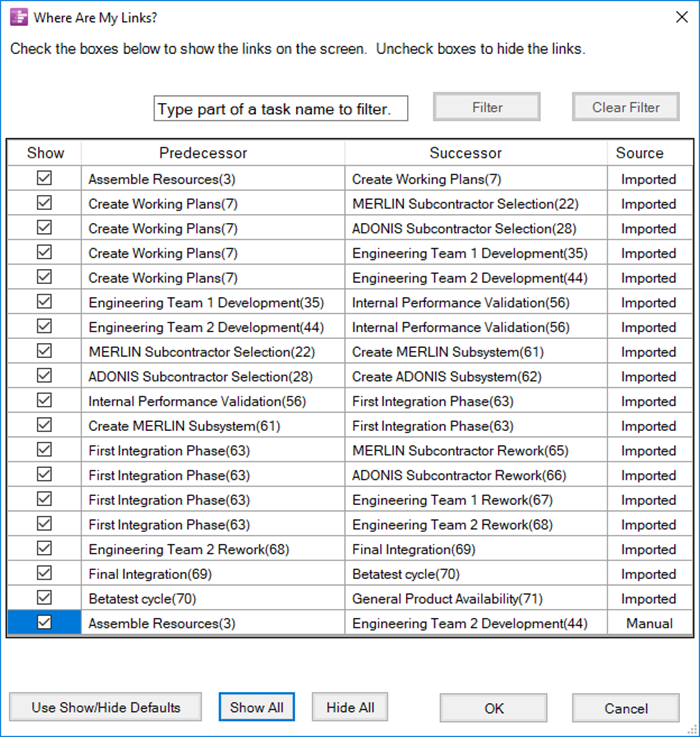
- c) If the Task Link is shown in the snapshot, the checkbox in the Show column is checked.
- d) The names and Unique ID of each pair of Predecessor and Successor task/milestones are shown in the form and the last column (Source) tells you if the Task Link was imported or created manually.
- e) You can use the checkboxes in the Show column to edit the show/hide status of any entry in the form. Unchecking an entry’s Show column checkbox hides the Task Link once you’ve clicked the OK button at the bottom of the form.
- f) The four columns in the form can be sorted by clicking on the column’s header.
- i) Shorting on the Show column means that you are sorting between checked and unchecked entries.
- ii) Sorting on the Predecessor or Successor columns means that you are sorting alphanumerically on the contents of the entire field.
- iii) Because of the relationship between these two columns, sorting on the Predecessor column, for example, brings along the corresponding Successor entry and vice versa.
- iv) Sorting on the Source column means that you are sorting between Imported and Manual entries.
- g) The three buttons at the bottom of the Where Are My Links? form are shortcut buttons which operates as follows:
- i) Use Show/Hide Defaults: When this button is clicked all Task Links in the snapshot have their properties reverted to the global settings in the PVP form’s Task Links tab.
- ii) Show All: Clicking this button makes all Task Links visible by setting the entire Show column’s checkboxes to check.
- iii) Hide All: Clicking this button hides all Task Links by setting the entire Show column’s checkboxes to unchecked.
- h) The contents in the Where Are My Links? form are specific to each snapshot as Task Links are snapshot-dependent.
Using Task Link Filter Rules
36) Since some Microsoft Project and Excel source plans can be fully constrained, that is have many tasks with Predecessor data, importing all data-driven Task Links can lead to a cluttered project view. Additionally, showing all data-driven Task Links might distract from the goals of your schedule conversation.
37) To deal with this, OnePager Pro and Express 6.1 has a Task Link Filtering rule capability that allows you to establish conditions under which data-driven Task Links are shown as described below:
- a) You have options in the Project View Editor (PVE) to show all data-driven Task Links, show only those that meet your specified Task Link Filtering rules, or show only those Task Links that you specifically desire shown.
- b) The Task Link Filter Rules form is provided for you to add, edit, and delete your Task Link Filter rules to control showing or hiding of individual Task Links.
- c) The Task Link Filter Rules form is accessed by going to the PVP form’s Task Links tab and first clicking the Use Rules radio button in the Data-Driven Task Links control group and then clicking the Manage Rules button as shown here:
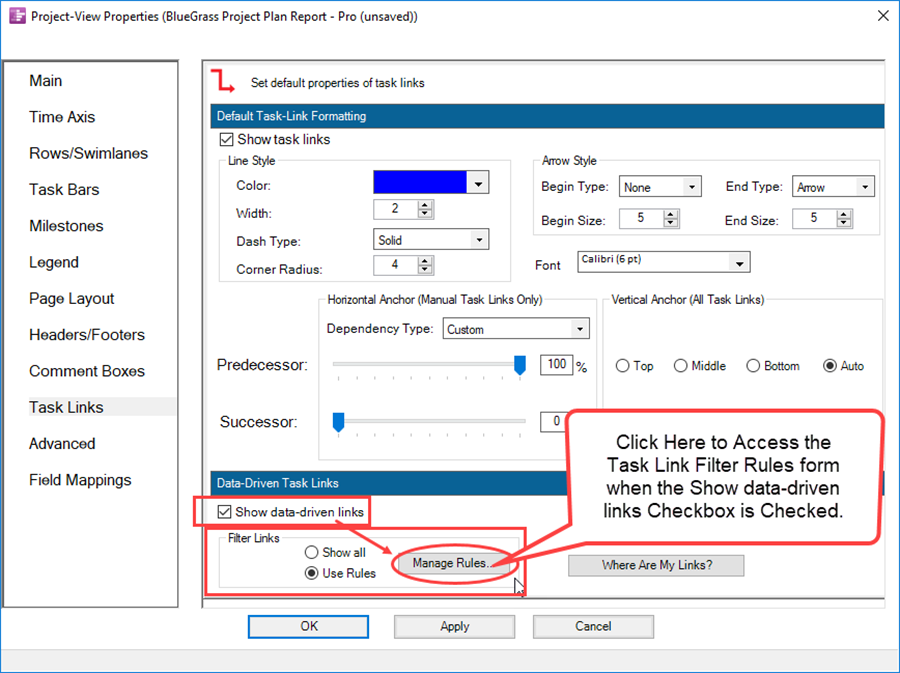
- d) The Task Link Filter Rules form is shown below:
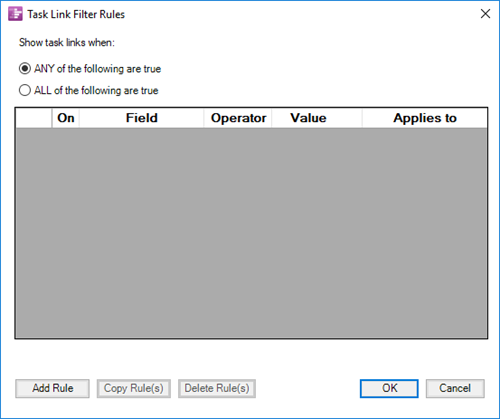
38) To demonstrate this capability, suppose you want to only show data-driven Task Links that relate to the ADONIS and MERLIN Subcontractor’s activities in the BlueGrass Project Plan Report – Pro project view.
- a) First, the project view with all the data-driven Task Links showing looks like this with some adjustment made to row height:
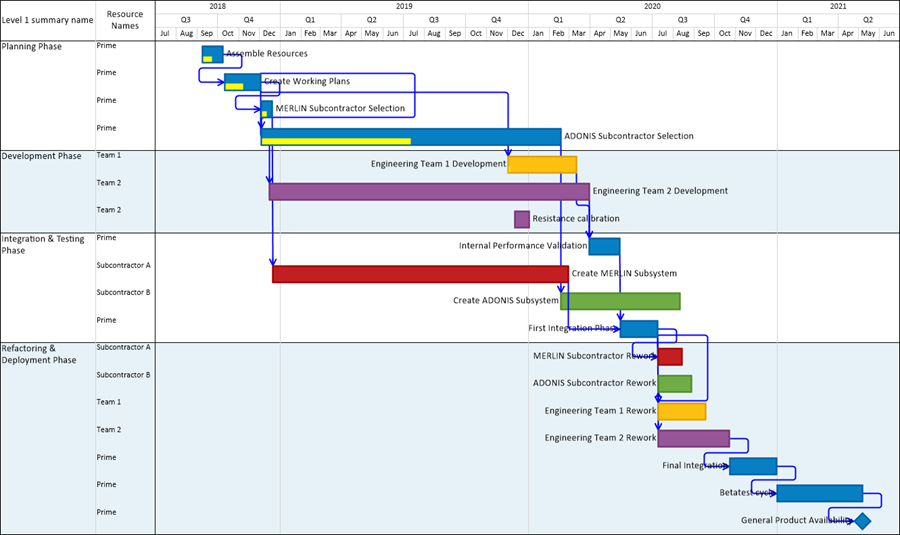
- b) The create Task Link Filter rules you need to access the Task Link Filter Rules form shown above which is done by going to the PVP form Task Links tab and first checking the Use Rules radio button followed by clicking the Manage Rules button.
- c) As shown in the form below are the two rules needed to filter data-driven Task Links and restrict the showing of data-driven Task Links to only those task/milestones involving the ADONIS and MERLIN Subcontractors:
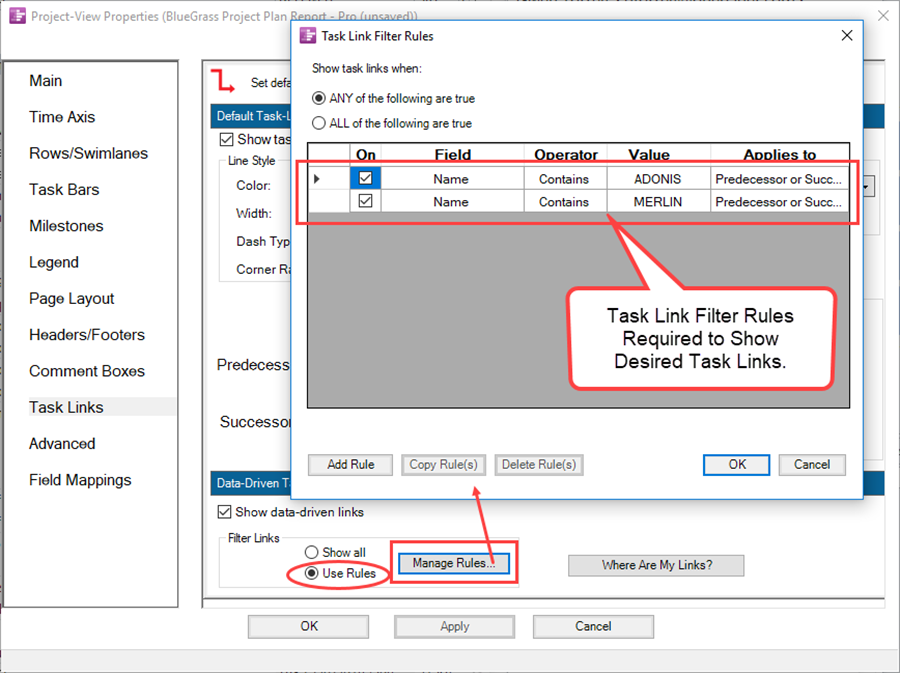
- d) When you click the OK button on the Task Link Filter Rules form and click either the Apply or OK button on the PVP form, the resulting project view looks like this with a little adjustment made to row height:
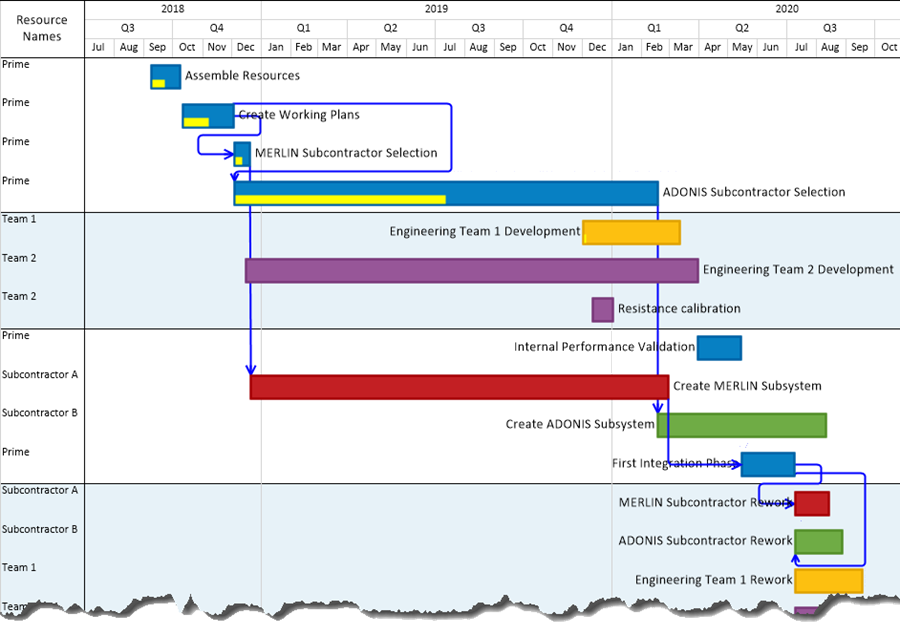
- e) The project view above is less cluttered and focused on those tasks/milestones (both Predecessor and Successor) that apply to the two subcontractors of interest.
- f) Note further that the individual data-driven Task Link manual editing features were used in the above project view to assure that the data-driven Task Links involved show their connection line routing clearly between predecessor and successor.
- g) Finally, if you look at the Where Are My Links? form you can see which entries are shown and which are hidden:
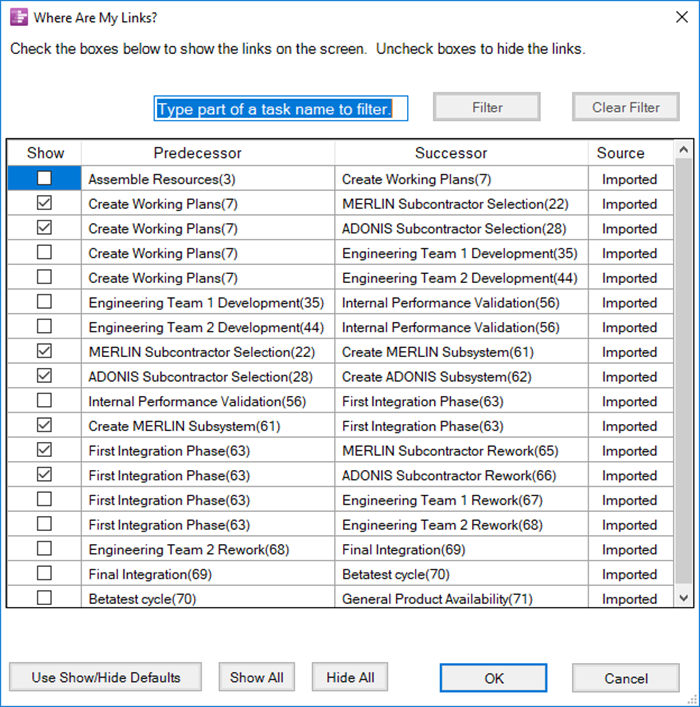
Globally Editing Task Links
39) In the Template Form: You can establish Task Link properties in the Template form’s Task Links tab as mentioned above. These Task Link properties are applied to all project views created with the Template.
- a) What is important to note with OnePager Pro and Express 6.1 is that you have the option in the Template form’s Task Link tab to define Task Link Filter rules prior to creating any project view.
- b) As long as the defined Task Link Filter rules remain defined in the Template form, these rules are always applied as the project view is initially created.
- c) A sample Template form with defined Task Link Filter rules is shown below:
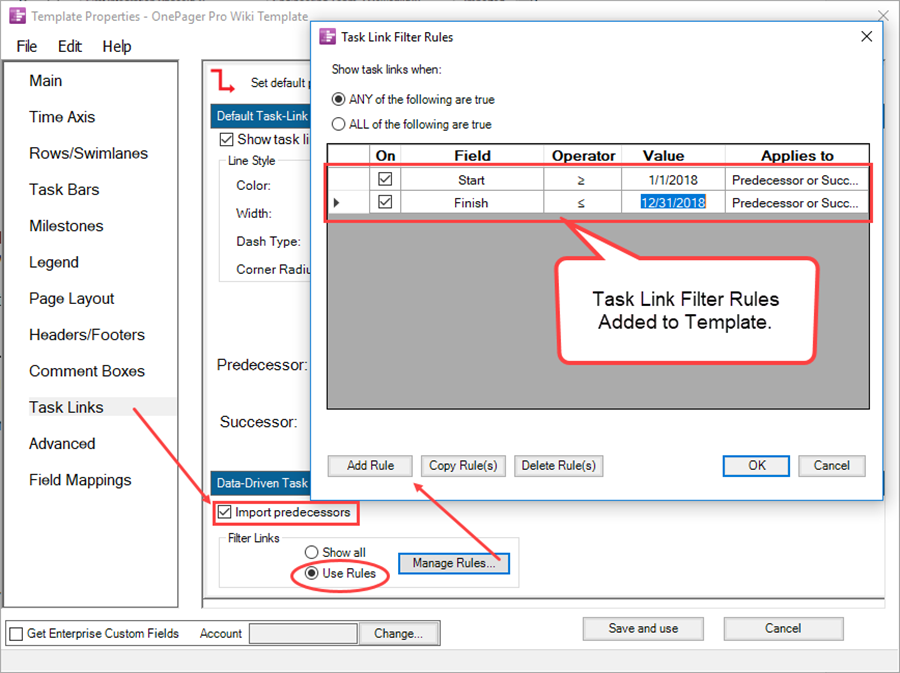
40) To access the Task Link Filter Rules form, the Import predecessors checkbox must be checked ON, and the Use Rules radio button selected. This activates the Manage Rules… button so you can click it and access the Task Link Filter Rules form.
41) Use the Add Rules, Copy Rule(s), and Delete Rules(s) buttons to create and manage your rule entries.
42) Any Microsoft Project or Excel field imported by OnePager Pro or Express 6.1 can be used in the Field column of the above form.
- a) The Operator and Value columns are tailored to the type of the Field column selection and the dropdowns are provided accordingly.
- b) The Applies to column lets you select if you want the rule to apply to only Predecessor task/milestones, Successor task/milestones, or both.
43) The Show task links when: set of radio buttons allow you to establish either an OR relationship between the active Task Link Filter rules or an AND relationship between the rules. This operates the same as with the Conditional Import Rules form.
44) When you have the rules defined, click the OK button on the Task Link Filter Rules form and the Save and use button on the Template form to save the rules and other Template form settings.
45) When this Template form is used to create a project view, the settings pertaining to Task Links are incorporated into the Project-View Properties form of the project view and can be refined once the project view is created as noted in the next section.
46) In the Project-View Properties Form: As mentioned above, the PVP form takes its initial Task Link settings from the Template form used to create the initial project view.
47) Task Link property settings can be edited at any time after the project view is created by accessing the PVP form’s Task Links tab and making the setting edits desired. Once the edits are applied, they are incorporated into the project view.
48) This also applies to Task Link Filter rules. Task Link Filtering is applied to the project view when it is created if the Template form’s Task Links tab was set up with Task Link Filtering rules.
- a) Once the project view is created you can access the PVP form’s Task Link tab and edit any Task Link Filtering rules.
- b) When you make such an edit, click OK in the PVP form’s Task Link Filter Rules form and click Apply or OK in the PVP form. OnePager 6.1 goes back to the source plan and reimports the source plan’s Predecessor information and applies the Task Link Filter rules from the PVP form.
- c) If you edit Task Link Filter rules in the PVP form’s Task Link tab, the modified Task Link Filer rules remain in effect for each subsequent snapshot created for the project view.
49) As with any other settings in the PVP form you can edit the settings in the Task Links tab without impacting the settings made to the original Template form.
Editing Task Links
Editing Data-Driven Task Links
50) Once data-driven Task Links are imported and shown they can individually be selected and edited as mentioned earlier with a combination of the left-click to select, right-click to access the context menu, and a click on the Properties … command to access the Task Link Properties form shown below:

51) Further, you can individually select a data-driven Task Link which, depending on its connection line routing, displays green and/or yellow grab points for your mouse.
- a) The green grab points are Begin and End point shapes for the Task Link and the yellow grab points are points where you can use your mouse to drag and drop the connection line as shown here:
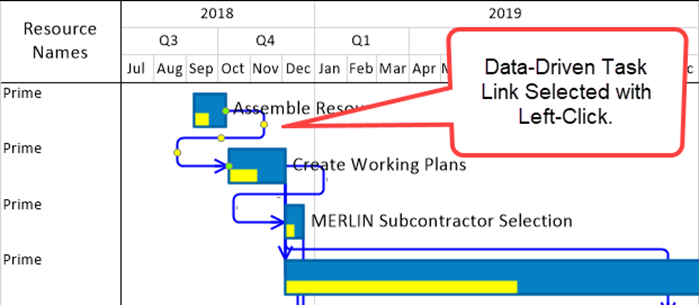
- b) Using the yellow grab points you can make manual adjustments to the connection line routing of a data-driven Task Link as demonstrated below:
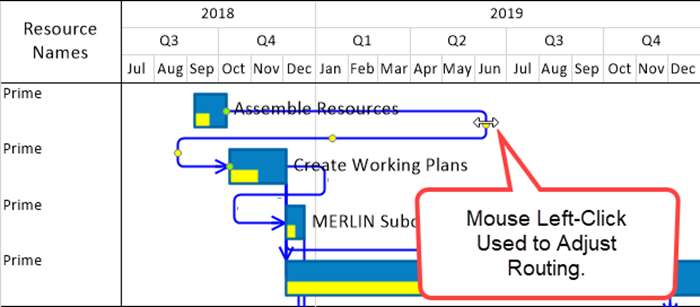
- c) The green grab points are used to reposition the Begin and End point shapes of the data-driven Task Link on its Predecessor or Successor task/milestone as shown below:
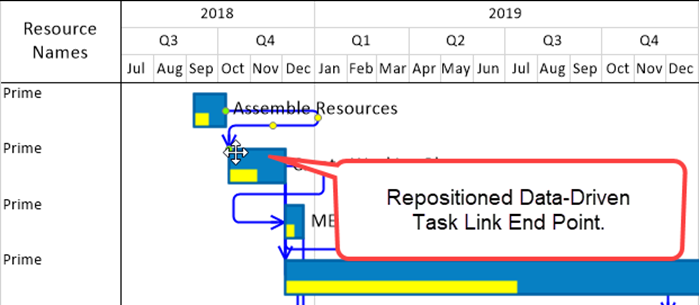
52) Making these and other manual edits to an individual Task Link makes the Task Link a maverick.
53) As shown in the Task Link Properties form above, a Mavericked Link can be restored to the default settings in the PVP form by clicking the Use Format Defaults button provided in the form.
Creating and Editing Manual Task Links
54) Manual Task Links, previously termed Event Links in earlier versions of OnePager Pro and Express, use the OnePager ribbon’s Insert tab to create a manual Task Link once the two participating task/milestones are selected.
55) The procedure is slightly altered in OnePager Pro and Express 6.1 and enhanced.
- a) In previous versions of OnePager Pro and Express selection of task/milestones to participate in creating a manual Event Link was by selecting the Successor task/milestone first followed by selecting the Predecessor task/milestone with a CTL+Left-Click.
- b) Once the two task/milestones were selected in this manner, you clicked the Event Link button on the ribbon’s Insert tab and OnePager created the Event Link.
56) In OnePager Pro and Express 6.1 the selection sequence has changed so that the procedure is to first select the Predecessor task/milestone followed by selecting the Successor task/milestone while using the CTL+Left-Click.
- a) This change was made because it is more intuitive to select the Predecessor before the Successor.
- b) This procedural change also provides a new enhanced capability to Daisy Chain manual Task Links thereby creating a sequence of two or more task/milestones in one operation that are connected by individual manual Task Links.
57) Once manual Task Links are created they can be edited as described above for data-driven Task Links. This applies to manual Task Link properties such as connection line color, dash type, and arrow shape but also to the ability to use your mouse to drag and drop the connection lines.
Creating and Editing Daisy Chained Manual Task Links
58) Creating Daisy Chained Manual Task Links: Creating a Daisy Chain of manual Task Links is a two-step process.
- a) First, using your mouse and the CTL+Left-Click, make a series of mouse selections of task/milestones in the order desired from Predecessor to the last Successor task/milestone as shown here:
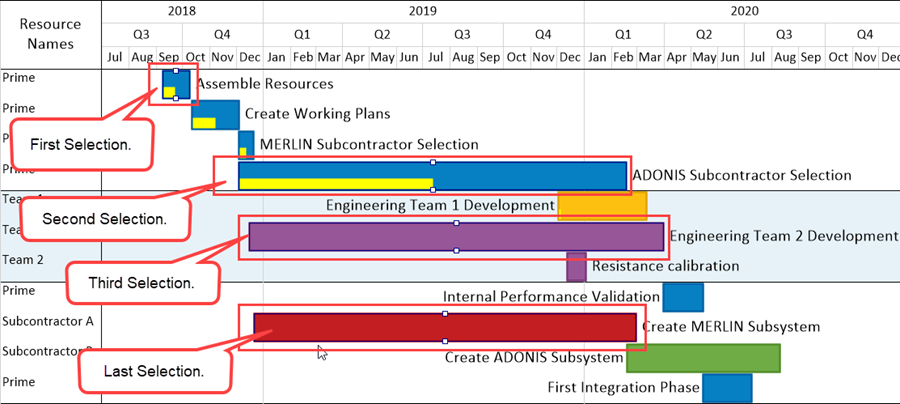
- b) The second step is to click the Task Link button on the OnePager 6.1 ribbon’s Insert tab shown here:

- c) At the completion of the second step, the project view looks like this after you increased the row height to better show the Daisy Chain of three manual Task Links:
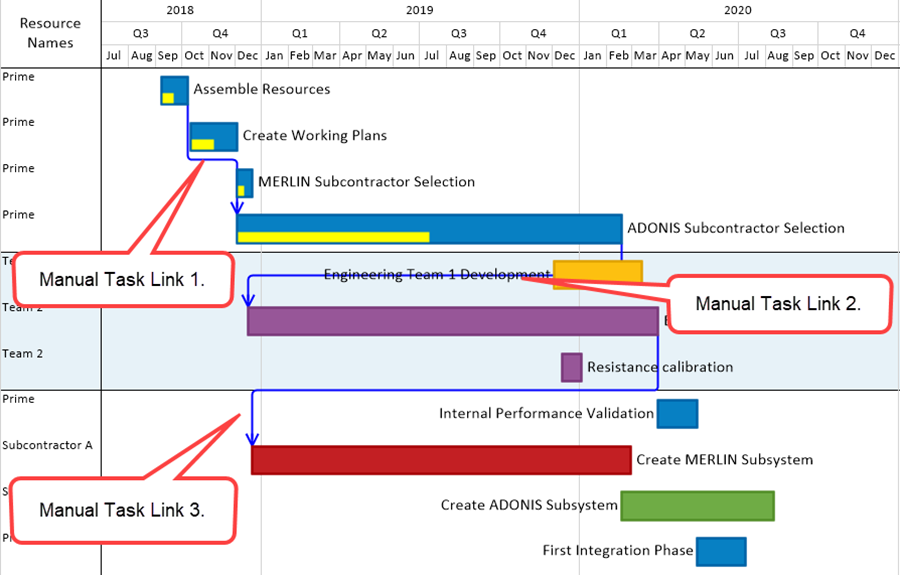
59) Manual Task Links created with this procedure are created as Finish-to-Start Dependency types and have connection lines routed by OnePager 6.1 to minimize conflicts with other graphics.
60) Alternative Method for Creating a Daisy Chain: Daisy Chained manual Task Links can also be created by selecting the tasks/milestones as described above but using the right-click on any selected task/milestone to access the context menu’s Insert task link(s) command to create the desired Daisy Chain as shown in the following example:
- a) Starting with the project view below where the selected task/milestones are to be connected with a Daisy Chained manual Task Link as the first step.

- b) The second step is to right-click any of the selected task/milestones to access the context menu shown below:
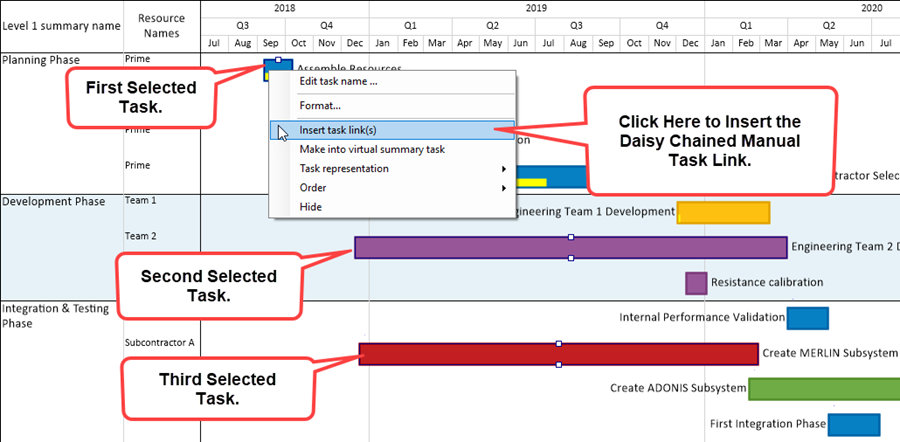
- c) When you click the Insert task link(s) command in the task/milestone right-click context menu the Daisy Chained manual Task Link looks like this:

61) Creating Daisy Chains with the Lasso and Select all Ribbon Options: For creating simple daisy chains of manual Task Links it can be easier to use the lasso technique with the mouse left-click drag and drop feature to select all the task/milestones you want to be included in the daisy chain of manual Task Links.
- a) For example, below the mouse is used to select all visible task/milestones by including them inside the lasso as shown:
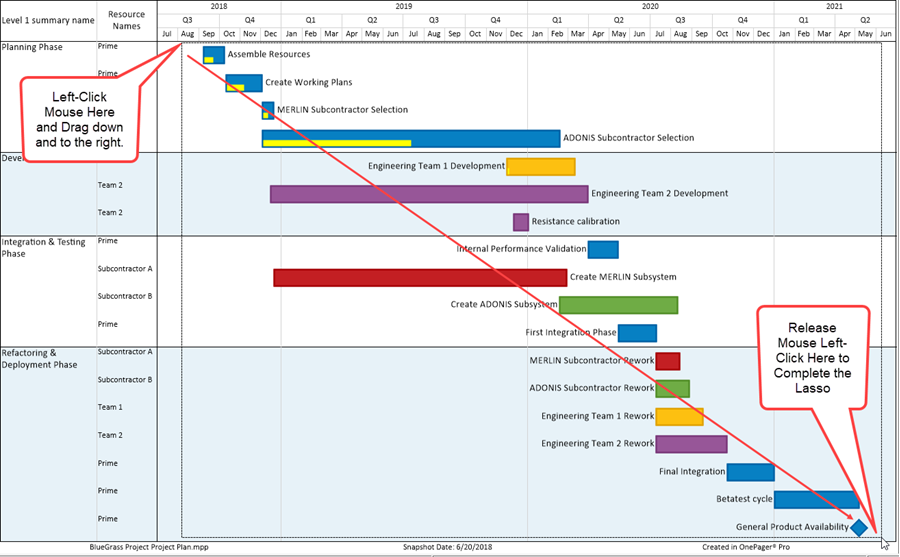
- b) Releasing the mouse left-click in the lower right of the project view selects all the task/milestones within the boundary of the lasso as shown here:
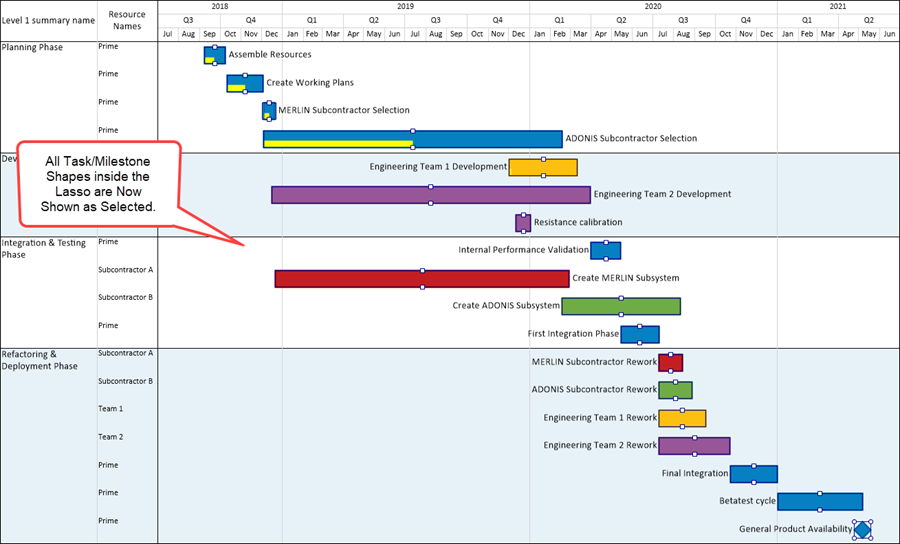
- c) To complete the process, right-click on any selected task/milestone to access task/milestone context menu and click the Insert task link(s) command.
- d) Doing this causes OnePager Pro or Express 6.1 to draw the daisy chain manual Task Links as shown below:
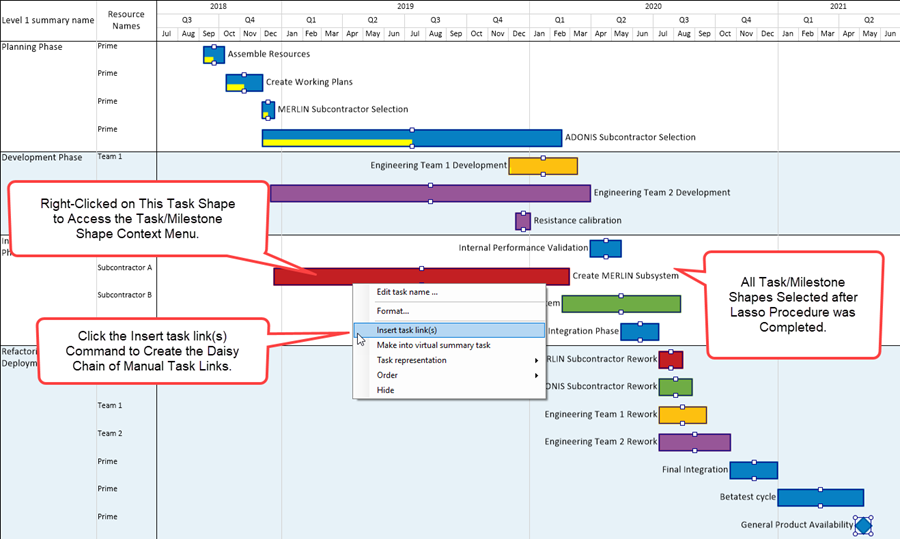
- e) As an alternative to using the lasso to select all task/milestones you can use the OnePager Pro or Express 6.1 ribbon’s Home tab in the Editing group of controls to make the selection.
- f) To do this click on the Select all dropdown control in the group and select the Tasks/Milestones command as shown here:

- g) Once all the task/milestones are selected proceed with a right-click on any selected task/milestone to access the context menu and click the Insert task link(s) command.
62) Using the lasso or the Select all technique to create a daisy chain of manual Task Links tells OnePager Pro or Express 6.1 that you want the resulting daisy chain to progress from upper left to lower right.
- a) Not selecting all tasks/milestones creates a daisy chain just involving those selected task/milestones with manual Task Links applied in the order that your manual selection of the task/milestones was made.
- b) If you need to select some task/milestones but not all by using the CTL+Left-Click technique for selection, OnePager Pro or Express 6.1 can create a daisy chain of manual Task Links in the order selected as shown below where not all visible task/milestones are selected.
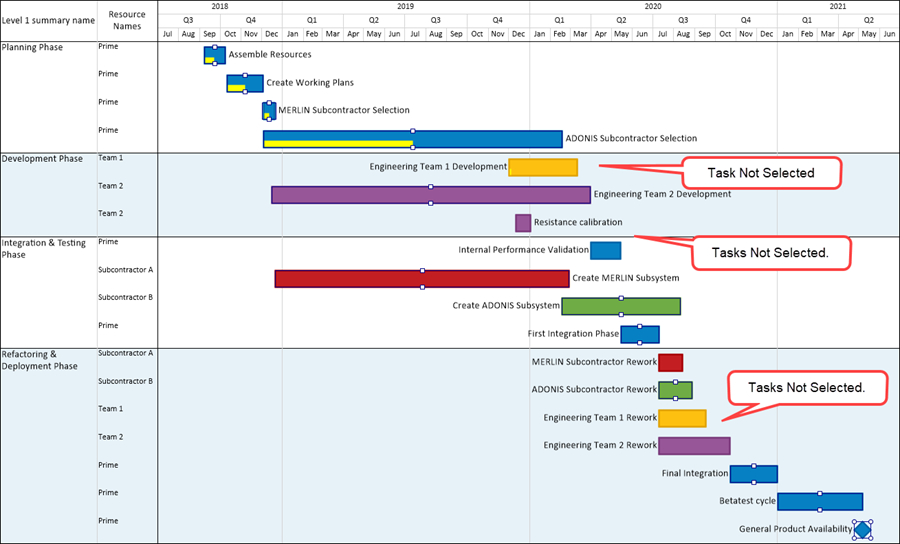
- c) With the project view and the task/milestone selections shown above, using either the ribbon command or the context menu command to Insert task link(s), results in the project view shown below:
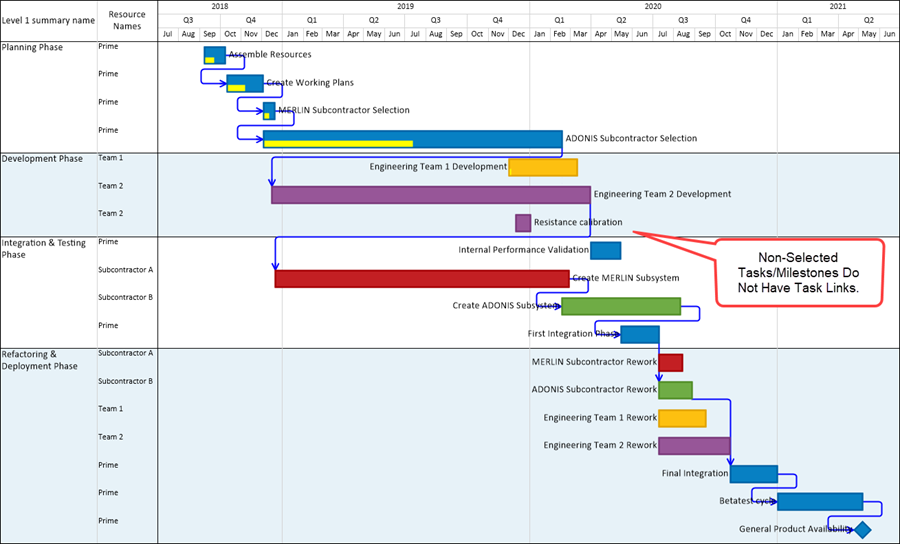
63) Caution: Some care is needed when using a combination of the lasso or Select all technique with individual task/milestone selections or de-selections to identify those task/milestones to participate in the creation of a daisy chain.
- a) If you do the combination of lasso and then, holding the CTL+Left-Click, you individually select additional task/milestones, OnePager Pro or Express 6.1 may not be able to follow your sequence and interpret your intentions.
- b) It is recommended that you do not combine these techniques for selecting task/milestones in a single action but use separate actions in individual steps with the Insert task link(s) command used between steps while making sure that selected task/milestones are de-selected between steps.
64) Editing Daisy Chained Manual Task Links: Manual Task Links can be individually edited as described above for data-driven Task Links as shown in the example below:
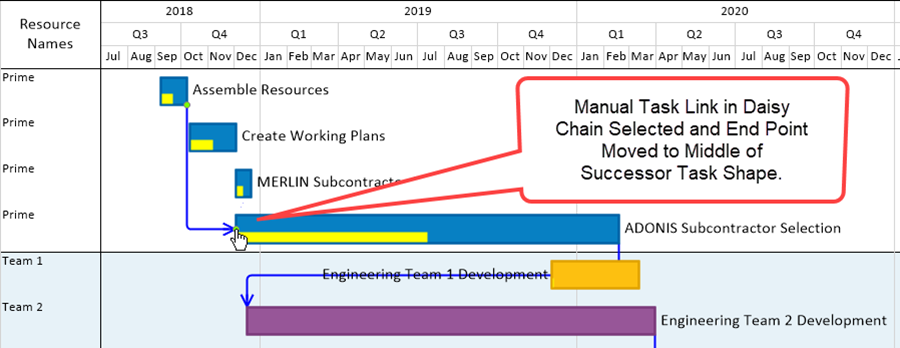
65) Although the right-click context menu for manual Task Links differs slightly from the context menu for data-driven Task Links, you can still use it to access the Task Links Properties form for any selected manual Task Link.
- a) Manual Task Links, even if created by the Daisy Chain method, can always be individually selected and their properties individually edited.
- b) Likewise, manual Task Links can have their default properties individually restored using the Task Link Properties form’s Use Format Default button.
- c) Using the UNDO button above the OnePager 6.1 ribbon immediately after a Daisy Chain of manual Task Links is created causes the entire Daisy Chain to be undone.
Task Links and Virtual Summary Tasks
66) As a bit of a review, a Virtual Summary Task (VST) is a summary task created by OnePager that does not exist in a Microsoft Project or Excel source plan. It represents the Start date and End date of two or more constituent tasks or milestones. In this respect the VST is a OnePager Summary task.
- a) OnePager computes the Start and End Dates of a VST as its constituent tasks dates change from snapshot to snapshot. It also constructs Baselines, Percent Complete Bars, and Critical Path Segments (One Pager Pro (OPP) only) for tasks being summarized.
- b) Details on creating and using the VST feature can be found at this article: Creating and Managing Virtual Summary Tasks.
- c) When Task Links exist on constituent tasks (whether manual or data-driven Task Links), and those constituent tasks are turned into a VST, the Task Links become hidden. Upon Unmaking the VST, the Task Links are again shown with their constituent tasks.
67) When Task Links are added to a VST (which can only be done with manual Task Links), and that VST is then broken up (i.e., unmade), the manual Task Links previously created are deleted permanently.
Task Links and Absorbing Tasks
68) A review on Absorption is provided here. The idea is to absorb one task or milestone into another task or milestone, leaving behind only a Comment Box (or perhaps several Comment Boxes) to indicate the presence of the Absorbed task/milestones.
- a) Please see the article at: Absorbing one task into another for instructions on how to perform the absorption function.
- b) In addition, to properly use the function, there are two control options found in the Template/Project-View Properties form at the Advanced tab in the Display options group of controls called Allow absorption and Show absorbed dates checkboxes.
- i) The Allow absorption checkbox must be checked ON for the absorb feature to operate.
- ii) Please see the descriptions for these controls at the Display Options section of these articles: Advanced Tab for OnePager Pro and Advanced Tab-OnePager Express.
69) When Task Links exist on constituent task/milestones being Absorbed (whether manual or data-driven Task Links), their Task Links become hidden. Upon Unabsorbing the constituent task/milestones, the Task Links are again shown with their constituent tasks.
70) Any Task Links that are attached to the task/milestones receiving the Absorbed task/milestones remain showing. When the Unabsorb task command is executed, the Task Links on the task/milestones receiving the Absorbed task/milestones remain showing.
71) When Task Links are added to a task/milestone that was Absorbed into (which can only be done with manual Task Links), and that Absorbed task/milestone construct is later broken down (i.e., using the Unabsorb task command), the manual Task Links previously created on the Absorbed into task/milestone remains showing.
72) As has always been the case, It is not possible to add a manual Task Link to a constituent task/milestone that was Absorbed because that absorbed task/milestone are only represented by a Comment Box after the Absorb function is complete.
Changes to Task Links when Moving Task/Milestones, Rows, or Swimlanes
73) You have the capability when editing the project view to move task/milestones up or down from Row to Row as well as to move Rows and Swimlanes with their respective content of task/milestones up or down in the project view.
74) When you make any of these three edits, data-driven and manual Task Links that are showing have their Task Link connection line geometry changed to retain the properties of the individual Task Links involved.
75) Given the portion of a project view with data-driven Task Links showing, what follows are three examples of how the project view changes when task/milestones, row, and swimlanes are moved:
- a) Here is the project view before any task/milestones, rows, or swimlanes are moved:
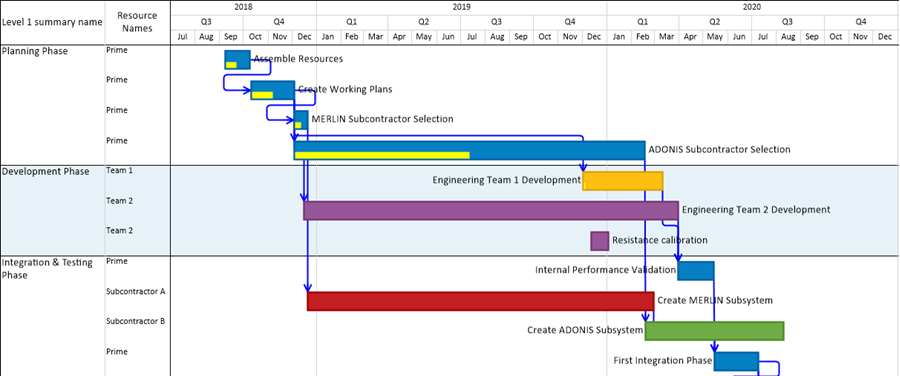
- b) After moving the Create Working Plans task to the bottom row of the project view above, the result looks like this:
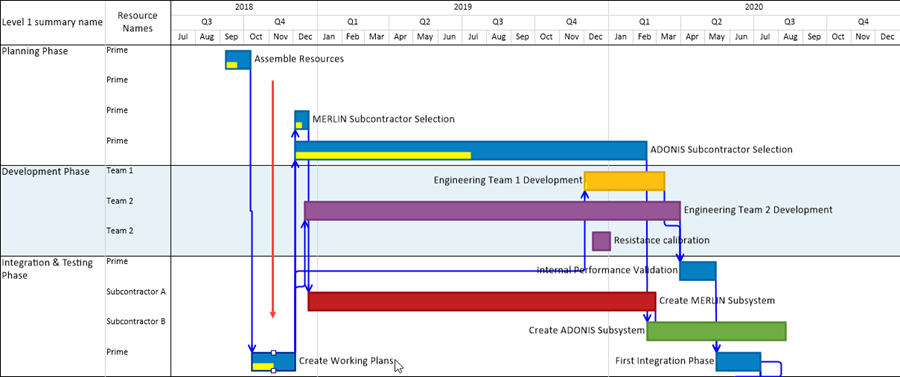
- c) Starting from the original project view, move the last Prime row in the Planning Phase swimlane to just above the last row in the project view. When this operation is completed the project view looks like the one below:
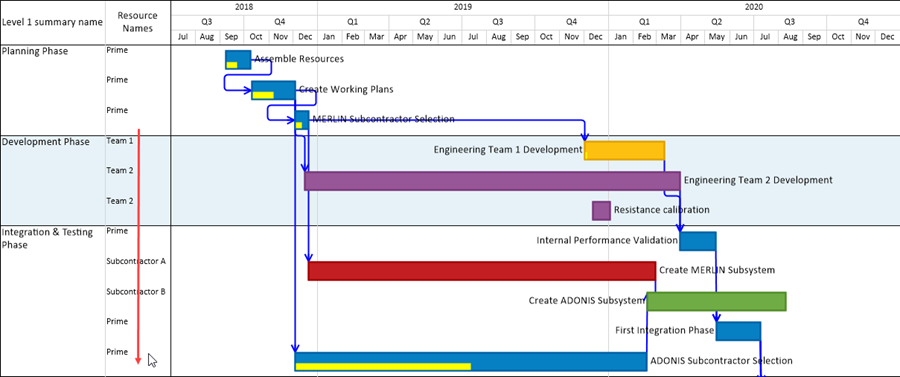
- d) Finally, from the original project view, move the Planning Phase swimlane to a position between the Development Phase and Integration & Testing Phase swimlanes. When completed, this project view looks like the following:
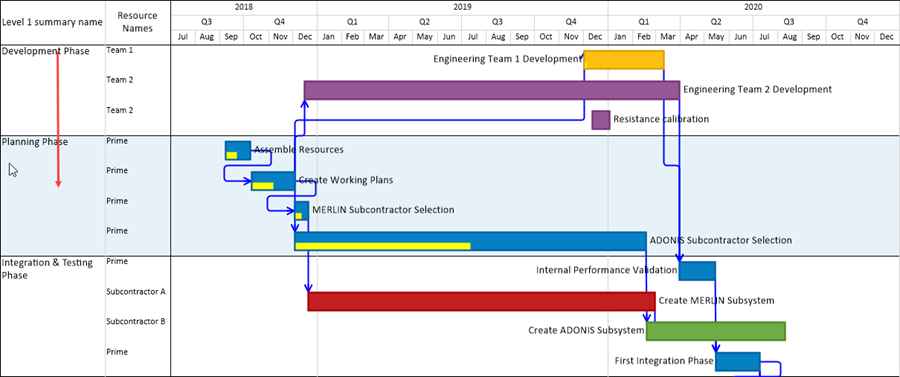
76) In the cases above, OnePager Pro and Express 6.1 attempt to route the data-driven and manual Task Link connection lines so as to minimize their length and avoid conflicts with other graphics in the Project View Editor.
Behavior of Data-Driven Task Links When Adding or Replacing Snapshots
77) OnePager Pro and Express 6.1 updates the presentation of data-driven Task Links in snapshots when you perform one of the Update workflows. These Update workflows include:
- (1) Performing a Replace-Dates, Replace-Dates and Progress, or Replace-All Properties for a snapshot.
- (2) Creating a NEW snapshot.
78) For the Replace-All Properties workflow there are two (2) situations that are specifically handled by OnePager Pro and Express 6.1:
- (1) If you make a change to a Predecessor task in the source plan (e.g., by changing a Start-to-Finish dependency to Finish-to-Finish), OnePager Pro and Express 6.1 makes the change to the Task Link Dependency Type during the Update. OnePager 6.1 does not process lag time for data-driven Task Links.
- (2) If the change involves no longer specifying a Predecessor task/milestone for a Successor task/milestone, the Replace-All Properties workflow deletes the data-driven Task Link from all snapshots.
79) For the NEW and REPLACE-Dates workflows, OnePager Pro and Express 6.1 hides the data-driven Task Link in the subject snapshot when there is no Predecessor task/milestone specified.
OnePager 6.1’s Data-Driven Task Link Import Process
80) Below is a brief overview of the OnePager Pro and Express 6.1 the import process for data-driven Task Links.
- a) OnePager Pro 6.1 can import standard predecessor field data from Microsoft Project source plans and show them in a project view totally under your control.
- b) OnePager Express 6.1 can do the same although you must tell OnePager Express 6.1 the name of the Predecessor field in your Microsoft Excel source plan and the syntax format selection to use.
81) The capability to show data-driven Task Links imported from your source plans can present some significant opportunities for helping to tell your schedule story.
- a) You now can use data-driven Task Links directly imported from your source plans without needing to manually create them.
- b) OnePager Pro and Express 6.1 ONLY imports available Dependency data from source plans when you turn the new Task Links feature ON (i.e., Check the Import predecessors checkbox ON in the Template form Task Link tab’s Data-Driven Task Links control group).
- c) You can later, after the project view is created, import data-driven Task Links by going to the PVP form Task Links tab and checking the Show data-driven links checkbox and specifying if you want to Show all data-driven Task Links or use Task Link Filter rules to selectively show imported data-driven Task Links.
- d) You have the capability to individually control the showing or hiding of data-driven Task Links.
- e) You have the capability to individually edit the properties of data-driven and manual Task Links.
82) These capabilities, however, present some challenges.
- a) Showing too many data-driven Task Links clutters the project view; potentially concealing important information.
- b) Too many data-driven Task Links can make graphics potentially difficult for your audiences to see.
83) The OnePager 6.1 Task Links Upgrade is designed to cope with these challenges through the following mechanisms:
- a) By default, OnePager Pro and Express 6.1 are typically launched with the data-driven Task Link feature turned OFF.
- b) The default OFF setting approach prevents the creation of a cluttered project view initially or a cluttered snapshot further on when the original project view is updated.
- c) OnePager Pro and Express 6.1 ONLY imports available Dependency data from your source plan when the feature is turned ON in either the Template or PVP form.
- d) Additionally, OnePager Pro and Express 6.1 does not show any data-driven Task Links unless their associated task/milestones are flagged for import and are within the Start/Finish Date boundaries.
- e) New tabs, called the Task Links tabs, are added to the Template and PVP forms so you have global control over all Task Links properties.
- f) Any Task Link, either manual or data-driven can be individually selected and edited as in previous version of OnePager.
- g) Manually editing any Task Link turns it into a Maverick Task Link.
- h) You have the capability to easily construct a Daisy Chain of manual Task Links.
84) After carefully determining how many and which Task Links to show in your schedule discussion graphic, you can set the Task Links feature ON. You can use the Task Link feature’s editing controls to determine which Task Links to show or hide and how they should look.
Import Process Summary
85) The flow chart below shows, in general, how OnePager 6.1 processes data-driven Task Links with imported task/milestones under your control:
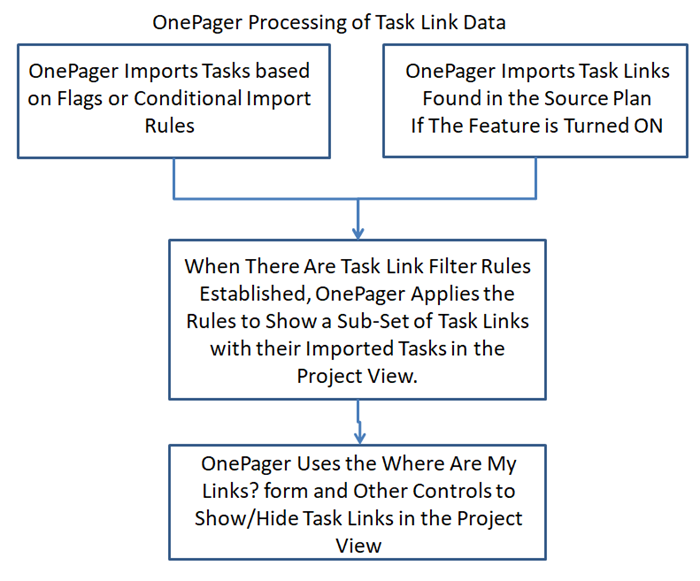
Saving OnePager 6.1 Project Views to Previous Versions
86) As with previous releases of OnePager Pro and Express you have the option to save project views (i.e., .TAM files) to previous versions.
- a) To save a project view to a previous OnePager Pro or Express version go to the OnePager Pro or Express 6.1 ribbon’s File tab and click the Save as tab which accesses the Save as project view window.
- b) Click the Save as type: dropdown and you’ll see the options as shown below:
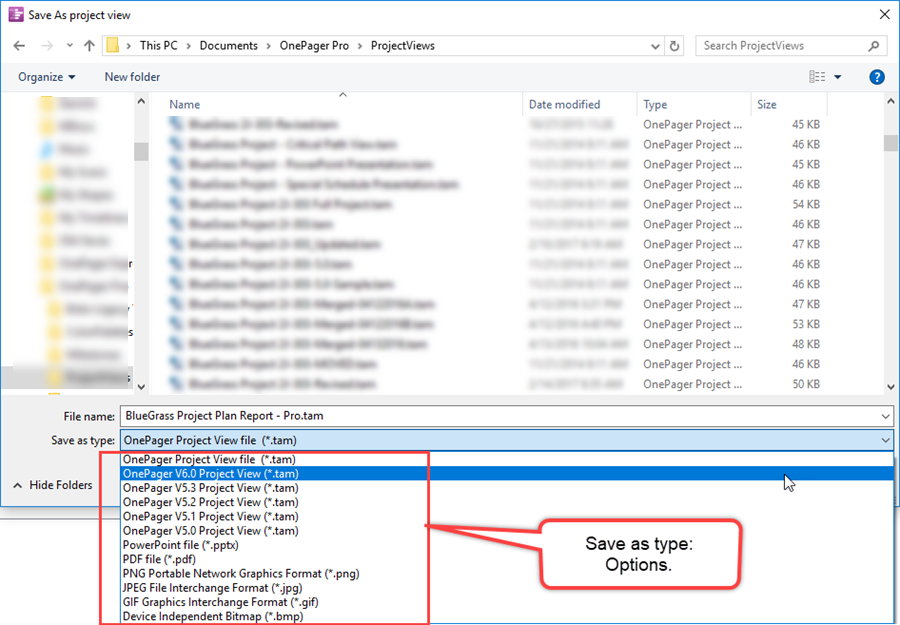
87) When saving a project view with data-driven Task Links, it should be recognized that the data-driven Task Link information is lost when the project view is saved to Version 6.0 or earlier version of OnePager Pro or Express and subsequently opened.
- a) Manual Task Links, however, are converted to Event Links which are compatible with previous versions.
- b) Manual Task Links converted to Event Links retain manual Task Link properties including connection line color, Dash type, and font properties. All other properties of manual Task Links converted to Event Links are lost.
- c) Enhancements made to manual Task Links like Begin and End point shapes and connection line Dash types are lost when saving to a previous version from version 6.1.
Opening Previous Versions of OnePager using OnePager 6.1
88) Opening a project view created with OnePager Pro or Express versions prior to version 6.1 with OnePager Pro or Express 6.1 provides a project view where only previously inserted Event Links, if any, are converted to manual Task Links.
- a) If a project view is being opened but was originally created with OnePager Pro or Express 6.1 and saved as a previous version no data-driven Task Links are available to be shown.
- b) If you open a previous version of a project view and subsequently Update the project view using OnePager Pro or Express version 6.1 with a source plan that contains Predecessor/Successor information, OnePager Pro or Express 6.1 imports this Dependency information if the Update method is Replace All Properties. Subsequent to the Update, the project view is able to show data-driven Task Links.
- c) Any Event Links present in the previous version of the project view being opened with OnePager Pro or Express 6.1 shows these links as manual Task Links.
Links to Detailed Articles
Related Links
Conditional Import Filters (Portal)
Conditional Formatting (Portal)
(0.4.1.7-61)